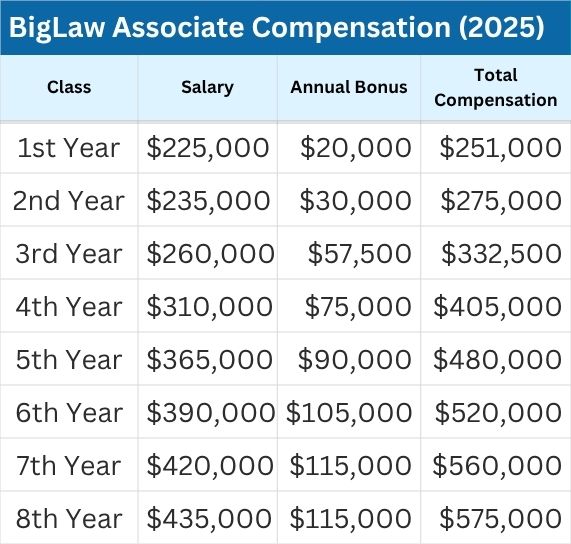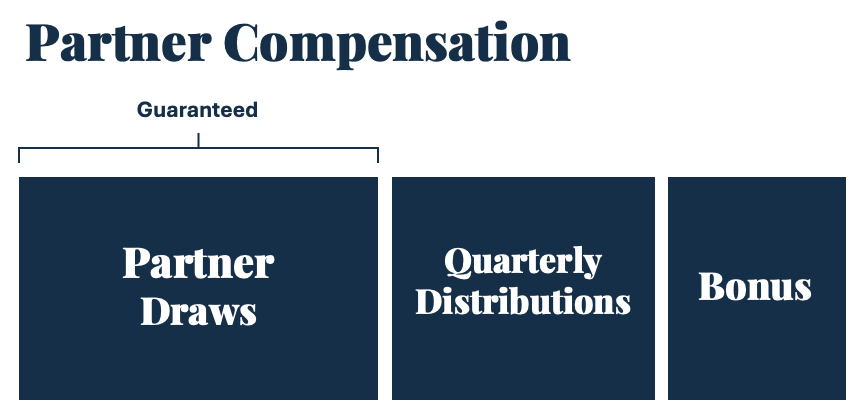By Joel Chouinard, ChFC®
October 23rd, 2025
If you're on track to make partner at your Big Law firm, you're about to experience a fundamental shift in how you're compensated. You're transitioning from employee to business owner, and that changes everything—from how you receive income to how you're taxed and how you manage your finances.
Many attorneys I work with don't fully understand these changes until after they've made the transition. By then, they're dealing with unexpected tax complexity, variable cash flow, and planning challenges they didn't anticipate.
This guide breaks down exactly how partner compensation works in Big Law and how it differs from associate pay, so you can plan ahead rather than scrambling to adjust after the fact.
How Does Associate Compensation Work in Big Law?
Before we explore partner compensation, let's establish the baseline: how you're currently paid as an associate.
As a Big Law associate, your primary responsibility is client work. Your compensation reflects this straightforward role through an equally straightforward structure:
Regular Paychecks: You receive predetermined salary payments, typically twice a month. These amounts are set at the beginning of the year and remain consistent throughout.
Performance Bonuses: If you meet your billable hour requirements, which vary from firm to firm, you're eligible for performance bonuses.
Predictable Compensation: Many Big Law firms follow the Cravath scale, which provides year-over-year predictability in compensation. You know what to expect based on your class year and performance. In 2025, the Cravath scale is illustrated below.

Source: BigLawInvestor.com
W-2 Reporting: All of this income is classified as wages and reported on a Form W-2. Your firm withholds taxes from each paycheck, and you file a relatively straightforward tax return as an employee.
This structure works well for associates. It's simple, predictable, and requires minimal financial planning complexity.
What Changes When You Make Partner?
Your Role Expands Beyond Client Work
Once you make partner, your responsibilities typically expand significantly. You're no longer just billing hours on client matters. You may take on business development responsibilities, firm management duties, committee service, associate recruiting, and strategic planning.
This expanded role comes with a compensation structure designed to reflect your new position as a business owner rather than an employee.
How Is Partner Compensation Structured?
Partner compensation in Big Law typically consists of three components, each serving a different purpose:

1. Partner Draws (Guaranteed Payments)
You'll still receive regular paychecks similar to your associate days, but these are no longer called wages or salary. Instead, you receive "draws" or "guaranteed payments."
These draws are typically predetermined at the start of the year, which gives you a baseline for budgeting purposes. Think of them as the stable foundation of your partner compensation—the amount you can reliably count on throughout the year. For example, if your guaranteed compensation is $450,000, you’ll receive 24 draws worth $18,750.
2. Quarterly Profit Distributions
This component is where partner compensation becomes more variable and where your financial planning needs to adjust significantly.
Whether you receive quarterly profit distributions depends entirely on your partner status:
Income Partners (Non-Equity Partners): Most Big Law firms use a two-tier partnership structure. You'll typically start as an income partner, which means you don't yet share in the firm's profits. Some firms pay "distributions" to income partners, but these are usually guaranteed and predetermined at the beginning of the year—essentially functioning as additional draws rather than true profit sharing.
Equity Partners: When you eventually "buy into" the firm and become an equity partner, you begin sharing in the firm's profits. These profits are distributed quarterly based on firm performance.
If the firm has a strong quarter, your distribution will be larger. If the firm underperforms, the distribution will be smaller. You can view these distributions as a return on your initial capital contribution—the amount you paid to "buy in" as an equity partner.
As an equity partner, you may also be required to make additional capital contributions as the firm grows or needs additional funding.
3. Year-End Performance Bonuses
Both equity and income partners may be eligible for year-end performance bonuses based on billable hours, client development, and other factors specific to your firm's compensation philosophy.
What's the Difference Between Income Partners and Equity Partners?
The distinction between income partners and equity partners is critical for understanding your compensation and planning needs.
Income Partners:
- Do not share in firm profits
- Receive guaranteed draws and potential bonuses
- Taxed as business owners despite not receiving profit distributions, although some firms treat income partners as W2 employees.
- Experience the tax complexity of ownership without the potential upside in income
Equity Partners:
- Share in the firm's quarterly profits
- Receive draws, profit distributions, and potential bonuses
- Made an initial capital contribution to "buy into" the firm
- May be required to make additional capital contributions over time
- Face both tax complexity and variable income which affects cash flow management
How Is Partnership Income Reported for Tax Purposes?
Here's the critical difference that catches many new partners off guard:
All partner income—whether draws, distributions, or bonuses—is classified as self-employment income and reported on a Form K-1, not a Form W-2.
This shift from W-2 to K-1 reporting has significant implications:
- You're now taxed as a business owner, not an employee
- Your firm no longer withholds taxes from your paychecks
- You're responsible for making quarterly estimated tax payments
- You're subject to self-employment tax on your income
- You may face multi-state tax filing requirements if your firm operates in multiple states
- Your tax return becomes substantially more complex (and costly to prepare)
This tax treatment applies to both income partners and equity partners. Even as an income partner who doesn't yet share in profits, you're taxed as a business owner.
*Note, a small subset of Big Law firms treat their income partners as W2 employees, so you’re a partner only in title, not from a tax standpoint.
What Does This Mean for Your Financial Planning?
For Income Partners
Looking at compensation structure alone, there isn't a dramatic difference between associates and income partners. Both receive guaranteed base compensation plus potential year-end bonuses.
However, the tax treatment creates immediate planning challenges:
You're taxed as a business owner even though you don't yet share in the firm's profits. You get the tax complexity of ownership—quarterly estimated payments, self-employment tax, potentially more complex multi-state filings—without the benefit of profit distributions.
Your financial planning needs to adapt to handle this increased tax complexity, even though your cash flow may remain relatively stable.
For Equity Partners
As an equity partner, you face both the tax complexity of ownership and the added challenge of variable income from quarterly profit distributions.
This combination affects multiple aspects of your financial life:
Cash Flow Management: Your quarterly distributions vary based on firm performance, which requires more sophisticated budgeting and cash reserve strategies.
Tax Planning: Variable income makes quarterly estimated tax payments more complex. Underestimate your income, and you'll face penalties. Overestimate, and you're giving the IRS an interest-free loan.
Long-Term Planning: Retirement contributions, college savings, and other financial goals become more complex to manage when a significant portion of your income fluctuates quarterly.
Capital Requirements: You need to maintain sufficient liquidity to meet potential capital contribution requirements from the firm.
Why Understanding These Changes Matters
Many attorneys approach partnership focused on the prestige and increased earning potential without fully understanding the structural changes coming their way.
The transition from associate to partner isn't just about making more money. It's about fundamentally changing your relationship with the firm—from employee to owner—and that shift requires different financial strategies.
Understanding partner compensation structure now, before you make the transition, allows you to:
- Build appropriate cash reserves for variable income
- Prepare for quarterly estimated tax payments
- Plan for potential capital contribution requirements
- Adjust your budgeting and spending patterns
- Work with advisors who understand Big Law partner taxation
The attorneys who navigate this transition most successfully are those who understand what's coming and plan accordingly.
What's Next: Understanding Partner Taxation
This article covered the structural differences in how partners are compensated compared to associates. The next critical piece is understanding how partners are taxed—including quarterly estimated payments, self-employment tax, and multi-state filing requirements.
These tax changes create the most significant planning challenges for new partners and require careful coordination to handle effectively.
Need Help Making a Plan?
If you're approaching partnership and want guidance on navigating both the compensation changes and tax implications, these transitions benefit from professional coordination.
Working with an advisor who specializes in Big Law attorney finances can help you develop strategies that account for your unique circumstances—so you can focus on your career and life rather than becoming an expert in partner taxation and financial planning.
👉 Schedule your free introductory call
👉 Learn more about our services & pricing
SharpEdge Financial LLC is a registered investment adviser registered with the State of Texas. Registration does not imply a certain level of skill or training. The views and opinions expressed are as of the date of publication and are subject to change. The content of this publication is for informational or educational purposes only. This content is not intended as individualized investment advice, or as tax, accounting, or legal advice. Although we gather information from sources that we deem to be reliable, we cannot guarantee the accuracy, timeliness, or completeness of any information prepared by any unaffiliated third-party. When specific investments or types of investments are mentioned, such mention is not intended to be a recommendation or endorsement to buy or sell the specific investment. The author of this publication may hold positions in investments or types of investments mentioned. This information should not be relied upon as the sole factor in an investment-making decision. Readers are encouraged to consult with professional financial, accounting, tax, or legal advisers to address their specific needs and circumstances.
